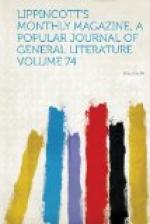THE LIFE OF GEORGE TICKNOR.[5]
[Footnote 5: Life, Letters and Journals of George Ticknor. Boston: James R. Osgood & Co.]
It is a long time since a more interesting biography has been published than this of Mr. Ticknor. No American book of the same kind can be compared with it, and very few have appeared in England that give the reader as varied glimpses of society and as many details in regard to interesting people as may be found in these two entertaining volumes. Its fullness in this respect is what makes the charm of the book. Mr. Ticknor’s life was a long one: from his youth he saw a great deal of the best society both of this country and of Europe, and he always had the custom of recording the impressions made upon him by the people he met. Hence this Life, which is for the most part made up of extracts from his letters and journals, is almost an autobiography, but an autobiography, one might almost say, without a hero, in which the writer keeps himself in the background and gives his main attention to other people. The editors have, however, given a full account of those parts of his life of which his own record is but brief.
He was born in Boston in 1791. His father, to judge from his letters, which are full of sensible advice, was a man of more than common ability, and he very carefully trained his son to put his talents to their best use. He had no stubborn material for his hands, for even in his youth Mr. Ticknor showed many of those traits which most clearly marked him in after life; among others, an intelligent, unimaginative, but also unmalicious observation of his kind for his




